 |
||||
|
||||
|
|||||||||||||||||
By Arthur Inkersley
If the question were asked, “What do you mean by the term French literature?” it may fairly be suppose that most people would reply, “Books by writers of French birth and education, written in the French language, for French readers, and published in France.”
On this principle Monsieur Taine’s “Notes on England” is a work of French literature, and Mr. P.G. Hamerton’s “Round My House” though describing life in provincial France, belongs to English literature. It is plain that, if we apply a similar definition rigidly to what is termed “Californian literature,” the proportions of that literature would shrink woefully. In fact, we shall have scarcely anything left.
The ordinary practice, however, is to claim as Californian every book written by a person who at any time resided in California, no matter what his nationality, or how short-lived his connection with the State. Thus Miss Beatrice Harraden’s “Hilda Strafford” is claimed as Californian literature, because its scene is laid in California and its author spent a winter here, though it is a tale written by a woman of English birth and education, and is intended to warn her countrymen, and especially her countrywomen, against rushing too enthusiastically into a life of which they have no accurate conception. So, too, Horace Annesley Vachell’s “The Quicksands of Pactolus,” which deals with some of the grotesque results produced by the sudden acquisition of great wealth in the West, is claimed as California, because it was first published in The Overland Monthly. Similarly it is the fashion to call Mark Twain a Californian writer, though he was born in Florida, “ran” a newspaper in Buffalo, started a publishing house in New York, and acquired must of his mining knowledge in Nevada. Yet it is evident that, unless this article is to stop here, I shall have to use the term “Californian literature” in the loose and vague sense that is almost, if not quite, universal. So let us glance at what has been called “the literate development of California.
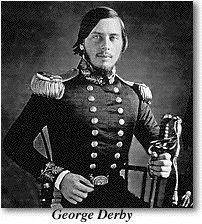 The first San Francisco magazine was
published in 1854, and was appropriately named The Pioneer. To its pages George Derby,
of the U.S. Military Engineer Corps, contributed some clever humorous sketches, which
were gathered together under the titles of “Phoenixiana” and “Squibob Papers.” Bishop
Kip published “The Unnoticed Things of Scripture,” and Col. John C. Cremony “Among
the Apaches.” Naturally, too, the parsons of pioneer times printed theological and religious
books, of no importance to the scholar and of little general interest; also volumes of
reminiscences, several of which I once read through, finding many interesting facts, but
nothing of literary value.
The first San Francisco magazine was
published in 1854, and was appropriately named The Pioneer. To its pages George Derby,
of the U.S. Military Engineer Corps, contributed some clever humorous sketches, which
were gathered together under the titles of “Phoenixiana” and “Squibob Papers.” Bishop
Kip published “The Unnoticed Things of Scripture,” and Col. John C. Cremony “Among
the Apaches.” Naturally, too, the parsons of pioneer times printed theological and religious
books, of no importance to the scholar and of little general interest; also volumes of
reminiscences, several of which I once read through, finding many interesting facts, but
nothing of literary value.
In 1860 Theodore H. Hittell published “The adventures of James Capen Adams, Mountaineer and Grizzly Bear Hunter of California,” which attracted some attention outside of the State. But widespread as was the interest felt in the gold of California in 1849 and the succeeding years, it was not until nearly twenty years later that the world began to feel any concern about the literary products of the Golden State. And even then the tales that have made California famous were, as might have been expected, produced by Easterners, who came here, stayed a few years, and went away again, most of them never to return.
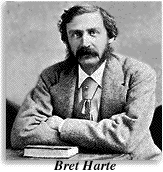 Francis Bret Harte, born in Albany, came out
to California as Secretary of the U.S. Branch Mint, and in 1866 published a volume
entitled “Outcroppings of California Verse,” which gave much offense, especially to those
whose effusions were not included within its covers. In 1867 “The Lost Galleon”
appeared; in 1869 “The Heathen Chinee,” and in 1870 “The Luck of Roaring camp.” After
editing The Overland Monthly for some time, Bret Harte grew too big for his environment,
and left California, now so many years ago that he has come to be regarded as a literary
giant of the misty past. To quote Mr. C. H. Shinn, “Unlike the other writers of the Pacific
Coast, he has not simply drifted away from us, but has frankly and avowedly left us for
ever, and seemingly without regrets or interest.” But, though his present address is No 74
Lancaster Gate, London, his inspiration is still drawn from the mining camps of the Pacific
Coast. His nearly life-long residence in other lands has been almost utterly unfruitful
of suggestion.
Francis Bret Harte, born in Albany, came out
to California as Secretary of the U.S. Branch Mint, and in 1866 published a volume
entitled “Outcroppings of California Verse,” which gave much offense, especially to those
whose effusions were not included within its covers. In 1867 “The Lost Galleon”
appeared; in 1869 “The Heathen Chinee,” and in 1870 “The Luck of Roaring camp.” After
editing The Overland Monthly for some time, Bret Harte grew too big for his environment,
and left California, now so many years ago that he has come to be regarded as a literary
giant of the misty past. To quote Mr. C. H. Shinn, “Unlike the other writers of the Pacific
Coast, he has not simply drifted away from us, but has frankly and avowedly left us for
ever, and seemingly without regrets or interest.” But, though his present address is No 74
Lancaster Gate, London, his inspiration is still drawn from the mining camps of the Pacific
Coast. His nearly life-long residence in other lands has been almost utterly unfruitful
of suggestion.
In 1867 appeared Mark Twain’s “The Jumping Frog,”
and in 1869 “The Innocents Abroad.” All Mark Twain’s work shows the strong impress of
his residence in California and Nevada, where, among miners and gamblers, he developed
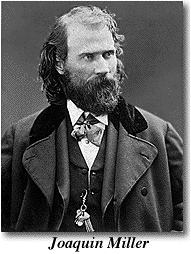 that characteristically irreverent, not to say uncultured and utterly inappreciative, way of
regarding the events of history and the monuments of antiquity that delight his admirers,
and sometimes render him, despite his genius as a humorist, a little boresome to the man of
cultivation.
that characteristically irreverent, not to say uncultured and utterly inappreciative, way of
regarding the events of history and the monuments of antiquity that delight his admirers,
and sometimes render him, despite his genius as a humorist, a little boresome to the man of
cultivation.
Some things do not lend themselves to humoristic treatment. Charles Warren Stoddard’s “South Sea Idyls” and his sketch of Father Damien show him to be a man of poetic temperament and great literary skill. Of Joaquin Miller it is difficult to speak enthusiastically; he is a poseur and a bit of a humbug; yet he possesses some poetic instinct and sense of melody; but he is so insensible to the charms of Truth that he is quite capable of writing of things and people he has never set eyes upon as though he were entirely familiar with them. This may not detract from the charm of a man’s poetry or from the value of his newspaper “stories,” but it certainly renders him an untrustworthy prose writer.
Of historians in California we have H.H. Bancroft and Theodore H. Hittell. The former
has been represented by many people who have had personal experience of him as a mere
sucker of other men’s brains, and a literary man for revenue only. Let us say that he is a
keen man of business, which means that he buys the best he can, as cheap as he can, and
sells it as dear as he can. He had certainly expended great pains and much money on the
compilation of histories of the various States of the Pacific Coast, in which great masses of valuable
facts have been accumulated. It is hardly likely that any one attempts to read any of these
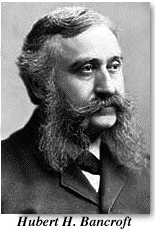 volumes straight through, but they are very useful storehouses, from which I have myself
occasionally pilfered. Mr. H.H. Bancroft does not possess the Greek sense of proportion,
and is not free from the national vice of turgidity, or the national fondness for rhetorical
outbursts.
volumes straight through, but they are very useful storehouses, from which I have myself
occasionally pilfered. Mr. H.H. Bancroft does not possess the Greek sense of proportion,
and is not free from the national vice of turgidity, or the national fondness for rhetorical
outbursts.
Of Mr. T.H. Hittell’s work I know nothing from personal examination, but am quite willing to believe that it displays considerable literary ability conjoined with a Teutonic conscientiousness and mastery of detail. His brother, Mr. John S. Hittell, is a painstaking literary worker, who has mainly confined his energies to California, but has sometimes made more ambitious excursions into the realms of philosophy and belief.
Henry George, the author of “Progress and Poverty” and other quasi-economical treatises, in which keen observation and strong sympathy are curiously blended with inaccurate reasoning and wildly impracticable schemes of social reform, lived for some time in San Francisco, but it is not easy to see that he might not have formulated his doctrines just as well in New York or London as here, where the evils he denounces are, or were, less prevalent. The Californian influence is certainly not specially discernible in his writings, which most people who have received a systematic training in logic and economics have read with interest, but without conviction.
Mr. George Hamlin Fitch, of Cornell University, has for many years been the literary critic
of the San Francisco Chronicle, and has earned a high reputation for his thoughtful reviews
of new books. He has contributed articles to The New Century, The Cosmopolitan, and
other magazines. Mr. Peter Robertson, dramatic critic of the same newspaper, has for
several years written the best theatrical criticism in the city, and has shown by his
“Undertones” and his operatic librettos that he has some creative talent as well. 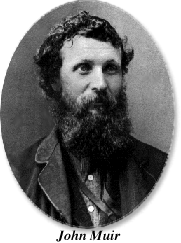 He is, I believe, a Scotsman, as is also the best of
our scientific writers, John Muir, whose “Mountains of California” show him to be
possesses of a loving and intimate knowledge of the Sierras and the Yosemite, and master
of a precise and agreeable literary style. There is space merely to name Professors Joseph
Le Conte and E.S. Holden.
He is, I believe, a Scotsman, as is also the best of
our scientific writers, John Muir, whose “Mountains of California” show him to be
possesses of a loving and intimate knowledge of the Sierras and the Yosemite, and master
of a precise and agreeable literary style. There is space merely to name Professors Joseph
Le Conte and E.S. Holden.
The crop of story-writers is, of course, the most abundant of all. The most successful, from a pecuniary point of view, and the worst, in a literary sense, of them all, is Archibald Clavering Gunter, who is what is quaintly termed “a Native Son.” Despite his injudicious selection of a birth-place he unquestionably can tell a rollicking good story, for “Mr. Barnes of New York” is more readable and genuinely interesting than many much better-written and more pretentious tales. His success is striking proof (if proof were needed) that to reach the heart of the average man is the most remunerative thing in the world; and, to do so, it is best to be an average man yourself; then you take an entirely commonplace view of the phenomena of life, and awaken no dangerous animosity in your readers.
Mr. W.C. Morrow is a brilliant short story writer, with a talent for minute analysis and the invention of strong situations. He tells a story skillfully, and keeps his mysteries cleverly concealed until the climax is reached. Recently a dozen or so of his stories, collected into a volume, were published by the J.B. Lippincott Co. Another writer of short stories is Mr. F.B. Millard, the Sunday editor of the Examiner, a volume of whose tales were lately issued in New York.
Mr. Charles F. Lummis wields a vigorous pen, and has made a special study of those parts of the United States which were once under Spanish rules. His “Land of Sunshine” is a lively monthly periodical, published in Los Angeles. Robert Duncan Milne is a Britisher by birth, and an Oxonian by education, but has done much literary work in California. His stories show a vivid, if not always a healthy, imagination, and he writes like a man of cultivation.
 But the most genuinely Californian writer is yet to be
named–Gertrude Franklin Atherton. She was born and spent her early days in
California, and all her stories, except her most recent ones, are of Californian life. She has
given us more exact and life-like pictures of the days immediately preceding the
American occupation of California than any one else. One of her latest novels, “Patience
Sparhawk and Her Times,” was very unfavorably commented on by various incompetent
persons, who found fault with its risqué situations and its severe views of
New York “society”; but all competent critics know that she possesses strength, an
agreeable literary style, and the faculty of telling a story.
But the most genuinely Californian writer is yet to be
named–Gertrude Franklin Atherton. She was born and spent her early days in
California, and all her stories, except her most recent ones, are of Californian life. She has
given us more exact and life-like pictures of the days immediately preceding the
American occupation of California than any one else. One of her latest novels, “Patience
Sparhawk and Her Times,” was very unfavorably commented on by various incompetent
persons, who found fault with its risqué situations and its severe views of
New York “society”; but all competent critics know that she possesses strength, an
agreeable literary style, and the faculty of telling a story.
Mrs. Kate Douglas Wiggin Riggs (to give the lady her full name) is a New Englander, who first earned her literary reputation in California. Her stories are chiefly for children, and it is in depicting the emotions of children that she excels. A year or so ago “Marm ’Lisa,” a longer story than any of her previous efforts, won favorable recognition.
Ambrose Bierce, of whose birth and
education little seems generally known, but who is certainly not a Californian, has written
verses and short stories, but is chiefly famous as a trenchant newspaper writer. His writing
is almost always bitterly satirical, and, if I desired to have a man roasted to a cinder, I
know of no one to whom the task could be more safely entrusted than to Ambrose Bierce.
Yet for all his power, he is a most uncomfortable writers; so ravenous is his appetite for the
horrible, and so keen his delight in keeping his readers’ hair erect and their eyes bulging
out of their sockets.
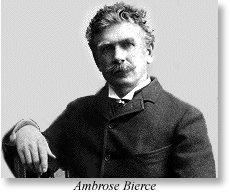 A short story by Ambrose Bierce is not to be commended to a man
sitting alone on a dark winter’s night in a room with loose doors or casements inclined to
rattle. Bright sunshine, dancing blue waves, the rustle of forest leaves, and the tinkle of
mountain streams seem to have little charm for Ambrose Bierce, and to those of us who
love these things he wears an uncanny look. He certainly has little of the healthy courage
and indomitable more and mental sanity that make R.L. [Robert Louis] Stevenson’s work
so charming and invigorating. He has also exercised his aptitude for the formation of
strange words to an excessive extent; the more so, as it is not based on any serious
philological acquirements.
A short story by Ambrose Bierce is not to be commended to a man
sitting alone on a dark winter’s night in a room with loose doors or casements inclined to
rattle. Bright sunshine, dancing blue waves, the rustle of forest leaves, and the tinkle of
mountain streams seem to have little charm for Ambrose Bierce, and to those of us who
love these things he wears an uncanny look. He certainly has little of the healthy courage
and indomitable more and mental sanity that make R.L. [Robert Louis] Stevenson’s work
so charming and invigorating. He has also exercised his aptitude for the formation of
strange words to an excessive extent; the more so, as it is not based on any serious
philological acquirements.
In conclusion, almost the only genuinely Californian literary products are Mrs. Atherton’s tales of Spanish-American life, and the stories of Bret Harte and Mark Twain, who plainly own their literary inspiration to the stirring days of the gold-hunters. The other writers mentioned, though the scenes of their tales may be California, brought with them from their widely-scattered homes the moulds in which their work is cast.
The great bulk of writing done in California records the impressions of people born and educated thousands of miles from the Golden Gate, and estimating life by standards widely different from those generally current on California and Market streets, or commonly accepted on Nob Hill and Pacific avenue. Their work is, therefore, not in any strict sense Californian literate. And, now that the impulse given to the imagination by the picturesque ante-Gringo period and “the days of gold” has pretty well died out, it is not easy to see just what direction the literary activity of California will take. Californian literature has had its Golden Age, and it is not unreasonable to expect that for many years to come there will be nothing specifically distinctive about it.